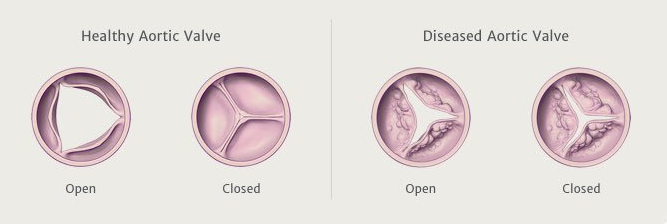Transcatheter Aortic Valve Replacement (TAVR)
TAVR for the treatment of Aortic Stenosis
What is Aortic Stenosis?
Your heart works every second of the day to pump the necessary blood throughout your body. The heart has four valves that play an important role in that process, one of which is called the aortic valve.
The aortic valve has thin leaflets of tissue that open and close when the heart beats to regulate blood flow. The aortic valve usually has 3 leaflets, therefore called a trileaflet valve. However, sometimes an aortic valve has 2 leaflets, which is called a bicuspid aortic valve. At times the leaflets of the aortic valve become stiff, which causes a narrowing of the aortic valve opening. The narrowing makes it harder for the heart to pump blood effectively and can cause the heart to weaken. This condition is called aortic stenosis.

Over time, aortic stenosis can lead to symptoms of difficulty breathing, increased fatigue, decreased activity tolerance, chest discomfort, lightheadedness, dizziness and fainting.
Definitive treatment of aortic stenosis includes surgical aortic valve replacement (open heart surgery) and a less invasive approach called transcatheter aortic valve replacement (TAVR). The decision to treat aortic stenosis is made after a consult with a team of heart specialists, who will work together to determine the best treatment option for each patient. To learn more about one patient’s experience with TAVR, read this article.
What is the TAVR Procedure?
Transcatheter Aortic Valve Replacement, or TAVR, is a less invasive, catheter-based procedure to replace the aortic valve for patients with severe aortic stenosis. The procedure is performed by an interventional cardiologist and cardiothoracic surgeon who will work together to place a new aortic valve in the diseased aortic valve through small incisions using a long thin tube (catheter) that is inserted in an artery in the groin or an artery underneath the collarbone. TAVR is performed on a beating heart and does not require a large surgical incision or support of a heart-lung machine.
You can even watch an animated TAVR procedure!
Benefits of TAVR
TAVR can offer reduction in symptoms, improved heart function and an improvement in quality of life. Because TAVR is a less invasive procedure, the recovery is much different than with open heart surgery and you may find your return to everyday activities much sooner. Typically, patients are able to go home the following day after a TAVR procedure.
In addition to your interventional cardiologists and cardiac surgeons, patients also benefit from the teamwork of nurses, nurse practitioners and physician assistants, cardiac rehab specialists and physical therapists and social workers to help you achieve outstanding outcomes and patient centered care. Your team of specialists will work with you to create a personalized care plan that is best suited for you and your needs.
To learn more about TAVR, call us at 218.249.3057.
For additional information, visit newheartvalve.com for resources provided by Edwards Lifesciences.
Looking for a provider?
Find information about provider related to Structural Heart Disease Program services.
Find Your Provider
